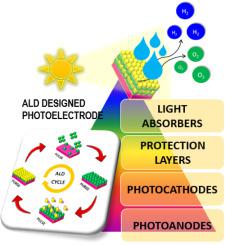Nano Energy ( IF 16.8 ) Pub Date : 2021-01-19 , DOI: 10.1016/j.nanoen.2021.105802 Amarnath T. Sivagurunathan , Sangeeta Adhikari , Do-Heyoung Kim

|
Presently, photoelectrochemical (PEC) water splitting is the most promising way to generate hydrogen in a clean and sustainable manner. However, enormous challenges need to be overcome in order to improve the efficiency of solar water splitting, which are attributed to the energy lost during the essential light-harvesting process, a result of the recombination of photogenerated charge carriers and the concomitant degradation of fabricated electrodes. Interfacial interactions between the electrode and electrolyte are crucial factors that govern the stability and the charge-transfer phenomena that affect overall PEC efficiency. With the advent of advanced engineering techniques, post-surface modification using atomic layer deposition (ALD) has garnered research attention because it can facilitate the development of nanostructure materials on the atomic scale, engineering of bandgaps, passivation of surfaces, improvement of catalysts, and modification of the light-harvesting properties of a surface. The present review focuses on exploiting ALD to improve the structural and surface properties of designed electrodes through the use of various ALD-deposited materials and on understanding their effects on PEC efficiency as well as provides a brief discussion on the fundamentals of PEC. Recent ALD projections that have contributed to enhancing the activities of PEC devices are also highlighted. Furthermore, this review summarizes the future outlook and potential of PEC water splitting, which has gained considerable interest in the current research sector.
中文翻译:

光电化学水分解中原子层沉积的策略和意义:最新进展和前景
当前,光电化学(PEC)水分解法是一种以清洁,可持续的方式产生氢的最有前途的方法。然而,为了提高太阳能水分解的效率,需要克服巨大的挑战,这归因于在基本的光收集过程中损失的能量,光生电荷载流子重新结合以及随之而来的电极退化的结果。 。电极与电解质之间的界面相互作用是决定稳定性和影响整体PEC效率的电荷转移现象的关键因素。随着先进工程技术的出现,使用原子层沉积(ALD)进行表面后改性已经引起了研究关注,因为它可以促进纳米级材料在原子尺度上的开发,带隙的工程化,表面的钝化,催化剂的改进以及对光吸收性能的改性。表面。本综述的重点是通过使用各种ALD沉积材料来利用ALD来改善设计电极的结构和表面性能,并了解它们对PEC效率的影响,并对PEC的基本原理进行了简要讨论。还重点介绍了最近的ALD预测,这些预测有助于增强PEC设备的活动。此外,本文还概述了PEC分解水的未来前景和潜力,











































 京公网安备 11010802027423号
京公网安备 11010802027423号